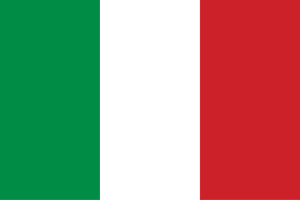
| Colors | HEX Code | RGB | CMYK |
|---|---|---|---|
| Green | #008C45 | 0, 140, 69 | 100, 0, 51, 45 |
| White | #FFFFFF | 255, 255, 255 | 0, 0, 0, 0 |
| Red | #CD212A | 205, 33, 42 | 0, 84, 80, 20 |
The Italian flag is a tricolor flag with three equally-sized vertical stripes. The green stripe is to the left, the white stripe is in the middle and the red stripe is on the right side of the flag.
Meaning of the Italian Flag
The green represents the Italian landscape and human values. The red color symbolizes love and the blood shed for the independence and unification of Italy. The white symbolizes faith and the snowy Alps.
History of the Italian Flag
The history of the Italian flag traces back to the late 18th century when the tricolor design gained popularity in various Italian states as a symbol of unity and independence. Inspired by the French Revolution, Italy adopted its tricolor flag in 1797, featuring green, white, and red vertical stripes. During Napoleon’s rule, a variant emerged with a red flag bearing a white diamond, green square, and golden eagle, though it was short-lived. In 1861, following the Risorgimento movement, Italy unified under the tricolor flag, adorned with a coat of arms representing the nation’s diverse regions. Throughout World War II, Italy saw variations in its flag under fascist rule, but in 1948, the modern tricolor—green symbolizing Italy’s lush landscape, white representing the Alps’ snow-capped peaks and purity, and red signifying the bloodshed in the struggle for independence—was officially adopted. Today, the Italian flag serves as a powerful emblem of national pride, reflecting the country’s rich history, cultural heritage, and enduring spirit of unity and resilience.